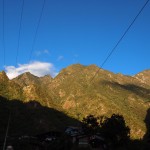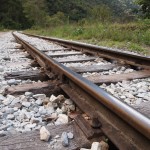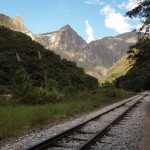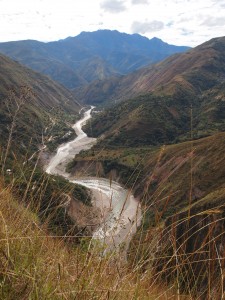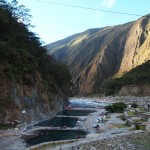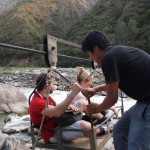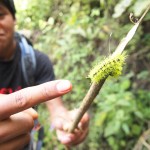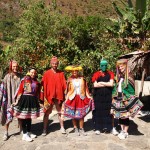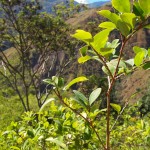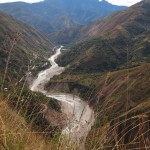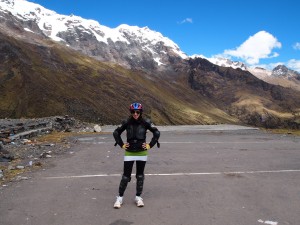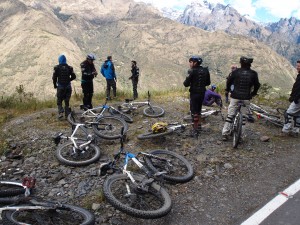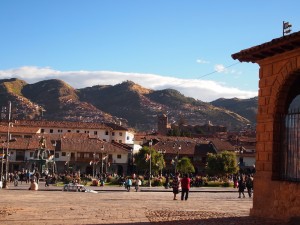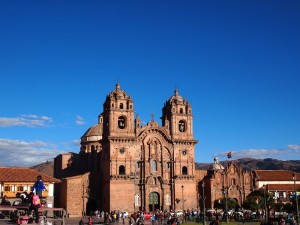Our third day started with a slightly bizarre zip-lining adventure. Sadly, I didn’t take a single picture, so I’m going to try my best to describe the experience without any visual aids…
Before we could start ziplining, we had to walk for 15 minutes up a ridiculously steep hill. There were no stairs, just an enormous dirt hill, with paths so perpendicular that they handed us ski poles to use on our way up. I must have been severely dehydrated from all the hiking the day before, because I could barely make it up the hill. By the time I reached the first zip line, I was breathless, seeing black spots and convinced I was going to pass out. Luckily sitting for 5 minutes and drinking a lot of water helped, and I was able to keep going. Scary though!
I’ve done a handful of ziplines, including a canopy tour in Costa Rica and adventure zip-lining in Mexcio, and absolutely loved all of my experiences, so this was byfar the part of the trek I was most excited for. I love the feeling of flying through the air, your feet dangling and the air rushing by you, yet knowing you are completely secure and safe. I had fun on these ziplines, but didn’t love the experience as much as I had hoped I would, which was definitely disappointing.
The actual ziplines themselves were fine; we had great harnesses and proper equipment, including thick gloves to break on the cable. Ironically, it was on the actual ziplines themselves that I felt the safest. The platforms we landed on after each zipline weren’t bolted to the ground/mountain — of course the cable we were on was well secured, but the wooden landing platforms were loose, so when I landed I felt very shaky coming off the line. Between ziplines, we had to walk along paths that were similar to the ones we walked on the day prior in that they were along the edge of the mountain, but they weren’t well marked and were full of lose dirt and gravel. I was more terrified on those paths than the ones I had been on the day before, and I felt more scared walking between ziplines than on the actual ziplines themselves.
I guess this just goes to show what expectations can do: I was the most terrified for mountain biking on day one, but it was by far my favorite of all the “extreme” activities. The zipline was the activity I was most looking forward to, but didn’t end up loving my experience.
On the last zipline, you landed in a platform in the middle of the air (literally, not bolted to anything, just suspended on the cable) and then were attached to a rapel line. The guide then rappelled you down into the jungle below, about 100 feet or so. I was terrified to land on the floating platform so I ended up breaking too early and pulling myself toward it instead. Dan, however, wasn’t told to break early enough and ended up smashing into the platform, right on his shin.
Immediately, a gigantic bruise/welt began to form, so huge we were all terrified he had broken his bone. He wasn’t in pain immediately because his body was in so much shock, so they took him to the urgent care in town to make sure he was okay. Luckily it was just a severe bump with a small cut, and they gave him an injection to prevent infection, some heavy painkillers for later and bandaged his leg. It did mean, however, that he couldn’t walk much on it during the rest of the day, so he had to take the train down to Aguas Callientes, the town at the base of Machu Picchu, and miss the rest of the day with the group.
After our rendezvous at urgent care, the zipline company drove us 40 minutes to our lunch spot. The van ride literally felt like the Indiana Jones ride at Disneyland — the road was so rocky and dusty, the van was literally shaking from side to side, it barely felt like we were moving forward, just rocking up and down. I have come to realize during my time in South America that drivers here — in all 5 of the countries I’ve been in — are absolutely insane. Peruvian drivers, however, are fearless. They will simply push on the gas pedal, with no qualms about the people or other vehicles that may be in the way.
We got to the restaurant for lunch relatively late because of Dan’s injury, so we were the last group to eat. I preoccupied myself with an absolutely tiny and adorable grey kitten, and there was a fütbol match on a TV in the corner, so all the boys were happy. Lunch was a sort of mystery chicken and potato in cream sauce, which was slightly strange, but they gave us two small scoops of ice cream, a very rich vanilla with chocolate chips, that did a great job satisfying my sweet tooth.
After lunch we had a 3 hour walk through the river valley along a set of train tracks. Everything was so picturesque that I kept stopping every 5 minutes to take pictures and ended up lagging behind the group. Juan Carlos stopped to join me, and we ended up walking together and talking most of the walk. We talked about everything from groups of Israeli travelers to relationships to his goal of going back to school to study Biology and eventually become a researcher in the Amazon jungle. I learned a lot about his life and about the Peruvian school system, which allows students to graduate from high school as early as 16. Turns out Juan Carlos went right to college to study tourism after high school, so even though he’s my age, he graduated from college at 20 and has already been working for 3 1/2 years.
I think on all of my trips and time in these various countries, the sites and cities have been really wonderful, but meeting local people and hearing about their experiences, especially when they welcome you into their lives with such open arms, is the most rewarding thing. Carla and Natalia at the B&B in Argentina, Monica and Miguel at their Estancia in Uruguay, even the hostel workers who took us to the soccer game in Montevideo. Yet another cliche, but hearing about local people’s lives and experiences really makes a country come alive.
Our walk was such a great way to end the trek into Aguas Callientes — of course my feet were still throbbing at the end, but it was nice to have a leisurely (and relatively flat!) walk to end the trek!
Because we had all booked the trip separately at different times through a variety of middlemen companies and for different amounts in different currencies (confusing, I know), Stian, Gene and Mat ended up at different hostels and restaurants from Dan, Millie and me on our last night. It was pretty disappointing after we’d had 3 great days hanging out getting to know each other that on our last night we couldn’t all be together, but I guess that’s what happens on these types of trips, especially since June is peak time in Machu Picchu, not everything was available.
After dinner, Dan, Millie and I officially decided to opt out of walking up the long set of steep stairs at 4:30 AM in the pitch black the next morning, and went to buy bus tickets instead. Even though I’m sure the walk up was a great experience and felt like a wonderful achievement (and I could have saved myself the $20 — Machu Picchu is expensive), I was so exhausted from all the physical activity of the last 3 days that I decided not to pressure myself to walk up. In my mind, it just wasn’t worth it, and I wanted to avoid being even more exhausted at Machu Picchu the next day.
We bought some very expensive snacks for lunch at the ruins the next day — Aguas Callientes is a very expensive, very touristy town since everyone has to pass through it to get to MP — and then went back to our hostel to pass out in preparation for our 4 AM alarms.

